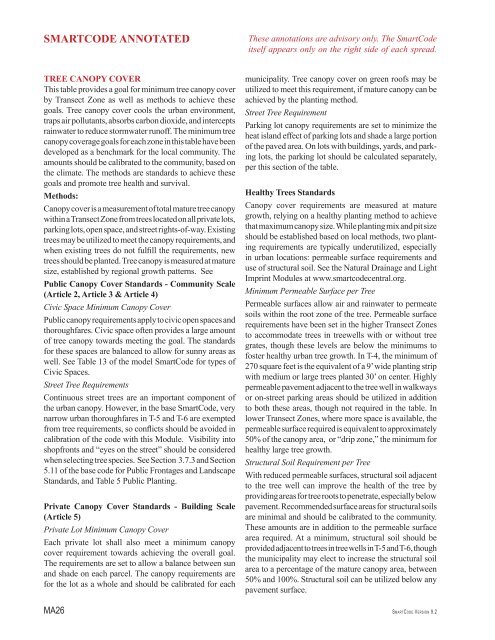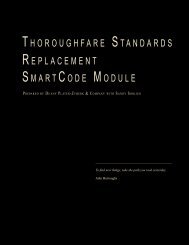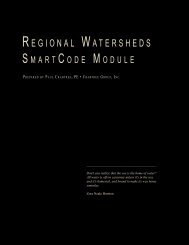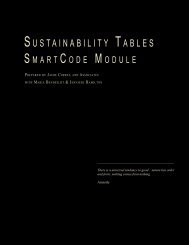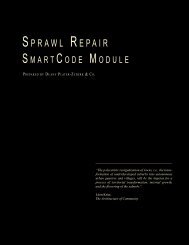U BANISM - Center for Applied Transect Studies
U BANISM - Center for Applied Transect Studies
U BANISM - Center for Applied Transect Studies
You also want an ePaper? Increase the reach of your titles
YUMPU automatically turns print PDFs into web optimized ePapers that Google loves.
SMARTCODE ANNOTATED<br />
These annotations are advisory only. The SmartCode<br />
itself appears only on the right side of each spread.<br />
TREE CANOPY COVER<br />
This table provides a goal <strong>for</strong> minimum tree canopy cover<br />
by <strong>Transect</strong> Zone as well as methods to achieve these<br />
goals. Tree canopy cover cools the urban environment,<br />
traps air pollutants, absorbs carbon dioxide, and intercepts<br />
rainwater to reduce stormwater runoff. The minimum tree<br />
canopy coverage goals <strong>for</strong> each zone in this table have been<br />
developed as a benchmark <strong>for</strong> the local community. The<br />
amounts should be calibrated to the community, based on<br />
the climate. The methods are standards to achieve these<br />
goals and promote tree health and survival.<br />
Methods:<br />
Canopy cover is a measurement of total mature tree canopy<br />
within a <strong>Transect</strong> Zone from trees located on all private lots,<br />
parking lots, open space, and street rights-of-way. Existing<br />
trees may be utilized to meet the canopy requirements, and<br />
when existing trees do not fulfill the requirements, new<br />
trees should be planted. Tree canopy is measured at mature<br />
size, established by regional growth patterns. See<br />
Public Canopy Cover Standards - Community Scale<br />
(Article 2, Article 3 & Article 4)<br />
Civic Space Minimum Canopy Cover<br />
Public canopy requirements apply to civic open spaces and<br />
thoroughfares. Civic space often provides a large amount<br />
of tree canopy towards meeting the goal. The standards<br />
<strong>for</strong> these spaces are balanced to allow <strong>for</strong> sunny areas as<br />
well. See Table 13 of the model SmartCode <strong>for</strong> types of<br />
Civic Spaces.<br />
Street Tree Requirements<br />
Continuous street trees are an important component of<br />
the urban canopy. However, in the base SmartCode, very<br />
narrow urban thoroughfares in T-5 and T-6 are exempted<br />
from tree requirements, so conflicts should be avoided in<br />
calibration of the code with this Module. Visibility into<br />
shopfronts and “eyes on the street” should be considered<br />
when selecting tree species. See Section 3.7.3 and Section<br />
5.11 of the base code <strong>for</strong> Public Frontages and Landscape<br />
Standards, and Table 5 Public Planting.<br />
Private Canopy Cover Standards - Building Scale<br />
(Article 5)<br />
Private Lot Minimum Canopy Cover<br />
Each private lot shall also meet a minimum canopy<br />
cover requirement towards achieving the overall goal.<br />
The requirements are set to allow a balance between sun<br />
and shade on each parcel. The canopy requirements are<br />
<strong>for</strong> the lot as a whole and should be calibrated <strong>for</strong> each<br />
municipality. Tree canopy cover on green roofs may be<br />
utilized to meet this requirement, if mature canopy can be<br />
achieved by the planting method.<br />
Street Tree Requirement<br />
Parking lot canopy requirements are set to minimize the<br />
heat island effect of parking lots and shade a large portion<br />
of the paved area. On lots with buildings, yards, and parking<br />
lots, the parking lot should be calculated separately,<br />
per this section of the table.<br />
Healthy Trees Standards<br />
Canopy cover requirements are measured at mature<br />
growth, relying on a healthy planting method to achieve<br />
that maximum canopy size. While planting mix and pit size<br />
should be established based on local methods, two planting<br />
requirements are typically underutilized, especially<br />
in urban locations: permeable surface requirements and<br />
use of structural soil. See the Natural Drainage and Light<br />
Imprint Modules at www.smartcodecentral.org.<br />
Minimum Permeable Surface per Tree<br />
Permeable surfaces allow air and rainwater to permeate<br />
soils within the root zone of the tree. Permeable surface<br />
requirements have been set in the higher <strong>Transect</strong> Zones<br />
to accommodate trees in treewells with or without tree<br />
grates, though these levels are below the minimums to<br />
foster healthy urban tree growth. In T-4, the minimum of<br />
270 square feet is the equivalent of a 9’ wide planting strip<br />
with medium or large trees planted 30’ on center. Highly<br />
permeable pavement adjacent to the tree well in walkways<br />
or on-street parking areas should be utilized in addition<br />
to both these areas, though not required in the table. In<br />
lower <strong>Transect</strong> Zones, where more space is available, the<br />
permeable surface required is equivalent to approximately<br />
50% of the canopy area, or “drip zone,” the minimum <strong>for</strong><br />
healthy large tree growth.<br />
Structural Soil Requirement per Tree<br />
With reduced permeable surfaces, structural soil adjacent<br />
to the tree well can improve the health of the tree by<br />
providing areas <strong>for</strong> tree roots to penetrate, especially below<br />
pavement. Recommended surface areas <strong>for</strong> structural soils<br />
are minimal and should be calibrated to the community.<br />
These amounts are in addition to the permeable surface<br />
area required. At a minimum, structural soil should be<br />
provided adjacent to trees in tree wells in T-5 and T-6, though<br />
the municipality may elect to increase the structural soil<br />
area to a percentage of the mature canopy area, between<br />
50% and 100%. Structural soil can be utilized below any<br />
pavement surface.<br />
MA26 S m a r t C o d e Ve r s i o n 9.2


